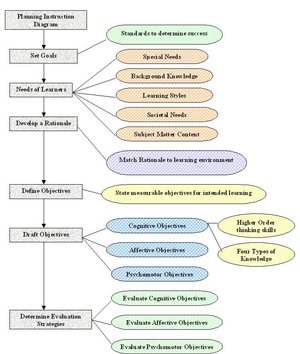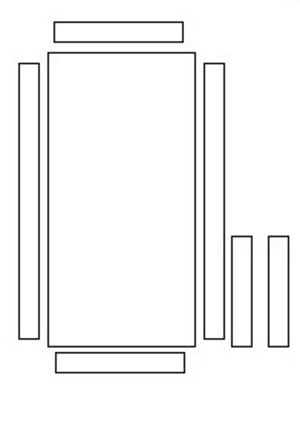In essence, there is no accurate procedure for good instruction; however, good instruction initiates with good organization and planning (Gunter, Estes& Schwab, 2003). Traditionally, educational institutions organize subjects into consecutively related courses then delineate them into units and lessons. Educators responsible for curriculum and instruction in an educational setting should concentrate on the needs of the students and have an effectual process to plan units, organize lessons, and prepare instruction (Gunter, Estes& Schwab, 2003). Students have a comprehensive understanding of what they are learning when educators reflect on the organization of content with awareness and can clarify why they communicate subject matter in a specific order (Gunter, Estes& Schwab, 2003). The following treatise will consist of questions that focus on the considerations of curriculum, instruction, and the needs of students for organizing and planning instruction. In addition, this treatise will include a diagram that depicts a framework for planning and organizing instruction.
Planning Instruction
Planning involves setting goals and developing a rationale for instruction, defining objectives, constructing a method of evaluation, and creating units of study that encompass the content of the course of study (Gunter, Estes& Schwab, 2003). Planning for instruction is a continual process, and the steps in planning are interdependent and overlap (Gunter, Estes& Schwab, 2003). In addition, planning instruction involves measurement techniques to determine student outcomes, thus aligning evaluation with instruction (Wiggins, 1993).
Setting Goals and Needs of Students
Goals offer a critical outlook of the educational process and establish standards augment success. Goals are purpose statements that reveal the needs of the student, the societal intention of education, and the course content students learn. Educators must reflect on, communicate, and include these goals in planning for instruction (Gunter, Estes& Schwab, 2003). Instructional planning must focus on the students; learning is more likely to take place when educators involve students in the process and offer students the occasion to explain what they comprehend. In addition, students need an association of what is to be learned and evaluation of what is taught (Gunter, Estes& Schwab, 2003). Notable learning often takes place when students associate what they already know to what they are attempting to comprehend (Gunter, Estes& Schwab, 2003). Furthermore, individuals learn differently and even though students learn in different means, some do have a favorite method to learn. Therefore, educators should instruct in a manner that permits students to learn the material by various means that will align success with learning preferences. This ideal also applies to students with disabilities both noticeable and unnoticeable (Gunter, Estes& Schwab, 2003).
Society also attends to the needs of students by establishing educational goals including proficiency in the fundamental skills, ethical values concerning behavior, respect for self and other individuals, achieve academic success corresponding to one’s abilities, and to develop the skills essential to be a productive member of society whether that be employment or additional education (Gunter, Estes& Schwab, 2003; Jorgensen, 2004). The material that is taught to students is consistently regulated by standards and usually aligns with federal, state, and district standards so much so that educators teach to test (Gunter, Estes& Schwab, 2003).
Developing a Rationale, Defining Objectives, and Drafting Objectives
Rationale is the explanation or reasoning for teaching what one wants to teach (Gunter, Estes& Schwab, 2003). This includes the motivations for the selection of goals, objective, and content. The rationale encompasses the goals and cultivates them into a narrative of the subject. Rationales should match the learning environment and be applicable to the needs of the students (Gunter, Estes& Schwab, 2003). The acknowledgement of goals in a rationale is important in the planning process but is too broad for lessons or evaluations. Educators need to state measurable objectives for the intended learning. Objectives offer an outline for specific instruction and permit educators and students to concentrate on the essential concepts of the material and serve as a basis to assess success of the instruction (Gunter, Estes& Schwab, 2003).
Objectives should maintain clarity in order to supplement the learning process and have three forms: cognitive, affective, and psychomotor. Cognitive objectives express the information that students are to learn. Affective objectives express the thoughts and viewpoints that students will likely develop. Psychomotor objectives communicate the motor skills that students are to learn. Instruction should incorporate both cognitive and affective objectives and psychomotor in lessons involving physical aspects. Cognitive objectives should also include higher-order thinking skills especially since students remember aspects more when they need to think about them (Gunter, Estes& Schwab, 2003).
Determining Evaluation Strategies
Evaluation assists in determining outcomes, if the students learned what was taught, this could be accomplished through tests, journals, activities, projects, and questioning (Gunter, Estes& Schwab, 2003; Marsh & Willis, 2003). Evaluation can be accomplished in a broad sense by assessing how students are interacting and the level of involvement within the classroom. The teacher can also focus on each student for interaction and involvement. In any case, evaluation procedures must correspond to learning objectives (Gunter, Estes& Schwab, 2003; Diamond, 1997).
Organizing Instruction
Organizing the instruction of a curriculum includes an assessment and articulation process, which aligns curricular progression with instructional methodology. Educators should organize course material in an orderly and interesting manner and place importance on the significant ideas. Educators should reflect on all factors relating to students to organize material and adjust accordingly for the needs of the class and individual students (Gunter, Estes& Schwab, 2003).
Analyzing and Ordering Content
Information within the classroom can be classified as facts, concepts, and generalizations. Educators should decide on the most significant grouping of these in the design process (Gunter, Estes& Schwab, 2003). According to Ausubel (as cited in Gunter, Estes& Schwab, 2003) there are two principles to remember when organizing and presenting content: ” (1) The single most important factor influencing new learning is what the learner already knows, and (2) any concept is explainable at many different levels of generality, with the highest or most general level most easily understood and the lowest or most specialized level the most difficult,” (p. 41).
Unit Design, Developing Lesson Plans and Objectives for Lessons
Units of study within a classroom frequently cover several weeks and focus on a broad idea or a group of concepts. Scope, focus, and sequence are three necessary components of unit design. Scope identifies the extent and span of content to be covered, focus establishes what will be highlighted in the content, and sequence indicates the progression in which the content will be given (Gunter, Estes& Schwab, 2003). Lesson plans are the elements that comprise the unit design. In developing lesson plans educators should restrict the concepts and content to be covered in a lesson to allocate time for the students to evaluate, perform, and comment on what they have learned. In addition, the material relates to previous learning, and regular confirmation to determine if students understand the intended knowledge (Gunter, Estes& Schwab, 2003). Deductive organization presents a generalization, rule, or definition as well as facts related to the generalization, rule, or definition. Students then make conclusions and predictions based on this knowledge. Inductive organization presents precise data and facts and through exploration and interpretation students form generalizations, rules, or definitions. Educators can also employ advance, expository, and comparative organizers in developing lesson plans (Gunter, Estes& Schwab, 2003). Advance Organizers are broad statements that aid students that place the material to be learned into context. Expository organizers originate at a higher spectrum than the ideas within the lesson. Lastly, comparative organizers relate new learning to prior learning (Gunter, Estes& Schwab, 2003). Elements of a lesson are associated with one another and to the reliability unit design; each lesson then should be part of the total learning experience. The objectives of the lesson should correspond to the objectives of the unit and the course (Gunter, Estes& Schwab, 2003; Diamond, 1997; Marsh & Willis, 2003).
Instruction Questions
What are the goals and rationale for instruction?
Are the objectives specific to the unit of study?
Does the content meet societal goals and standards?
Will the objectives bring about the desired learning?
Does the rationale match the learning environment?
What are the objectives?
Do the objectives contain both cognitive and affective objectives and psychomotor where necessary?
Are there higher-order thinking skills to engage students?
What instructional model should be used?
How should the students be evaluated?
Are there reasonable means to evaluate what was taught?
Are the evaluations appropriate for cognitive, affective or psychomotor objectives?
Curriculum Questions
Is there a plan in place for the presentation of content?
Is the course design well structured so that students will be able to recognize the order and determine how the parts fit into the whole?
Does the content contain fact, concepts and generalizations?
Is the order of the content presented based on the work of Ausubel? New learning built on prior learning and at any stage of learning and understanding build on previous general levels of learning and understanding?
Is the scope of the lesson adequate?
Is the curriculum in compliance with the regulatory requirements at all levels?
Student Needs Questions
What are the expected outcomes for the students?
Is there meaningful engagement in the learning process for students?
Is there enough direct contact with what is to be learned?
Are the students able to explain understanding of the lesson?
Does the evaluation method test what is taught?
Has ample evaluation been given for prior knowledge?
Have learning styles been determined?
Does the content relate to multiple intelligences?
Conclusion
The preceding treatise offers insight into the organization and planning of instruction. Organization and planning on the part of educators requires close attention in order to ensure the needs of the students are met and learning occurs. There is no single method for curriculum and instruction that will serve all students equally given the diverse population. However, educators can have a starting point and apply suitable adjustments for students when necessary. Effective curriculum and instruction will respond to student’s levels of readiness, interests, and methods of learning (Tomlinson, 2005).
References
Diamond, R. M. (1997). Designing and assessing courses and curricula. A practical guide. San
Franciso: Jossey-Bass
Gunter, M. A., Estes, T. H., & Schwab, J. (2003). Instruction: A models approach (4th ed.).
Upper Saddle River, NJ: Pearson.
Jorgensen, C.H. (2004). Connecting work and education: Should learning be useful,
correct or meaningful? Journal of Workplace Learning, 16. Retrieved June 25, 2007
from ProQuest database.
Marsh, C. J., & Willis, G. (2003). Curriculum: Alternative approaches, ongoing issues (3rd ed.).
Upper Saddle River, NJ: Pearson
.
Tomlinson, C.A. (2005). Quality curriculum and instruction for highly able students.
Theory into Practice, 44. Retrieved June 26, 2007 from ProQuest database.
Wiggins, G. P. (1993). Assessing student performance: Exploring the purpose and limits of
testing. San Francisco: Jossey-Bass.



